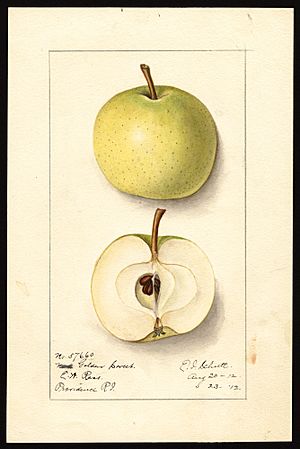Golden Sweet facts for kids
Quick facts for kids Malus domestica 'Golden Sweet' |
|
|---|---|

Golden Sweet apple
|
|
| Species | Malus domestica |
| Origin | |
The Golden Sweet is a special kind of apple. It is a 'cultivar,' which means it's a specific type of apple that people have grown and chosen for its unique qualities. This sweet apple is known for its delicious flavor and is a popular choice for many uses.
Contents
Where the Golden Sweet Apple Comes From
The Golden Sweet apple first appeared in the American state of Connecticut. This happened way back in 1832. We know where and when it started, but the exact parent apples that created the Golden Sweet are still a mystery.
How Big is a Golden Sweet Apple?
Golden Sweet apples are usually medium to large in size. This means they are bigger than some apples you might see, but not the biggest.
When Golden Sweet Apples are Ready to Pick
Golden Sweet apples usually ripen from late July through early August. The exact time can change a little depending on where they are grown. Sometimes, the harvest can even continue into September. This makes them one of the earlier apples to be ready in the season.
What Does a Golden Sweet Apple Taste Like?
The flavor of a Golden Sweet apple is very sweet and rich. It has almost no tartness, which means it isn't sour at all. Many people describe its taste as "honey sweet" because it reminds them of honey. This apple is perfect if you love a truly sweet fruit without any sour taste.
When Golden Sweet Trees Produce Apples
Golden Sweet apple trees tend to produce a lot of apples every other year. This means one year they might have a huge harvest, and the next year they might have fewer apples. This is a natural way for some apple trees to manage their energy.
How People Use Golden Sweet Apples
Golden Sweet apples are great for eating fresh, right off the tree! Their sweet flavor also makes them perfect for making apple sauce. They are also a good choice for pressing into apple cider, which is a popular drink made from apples.

